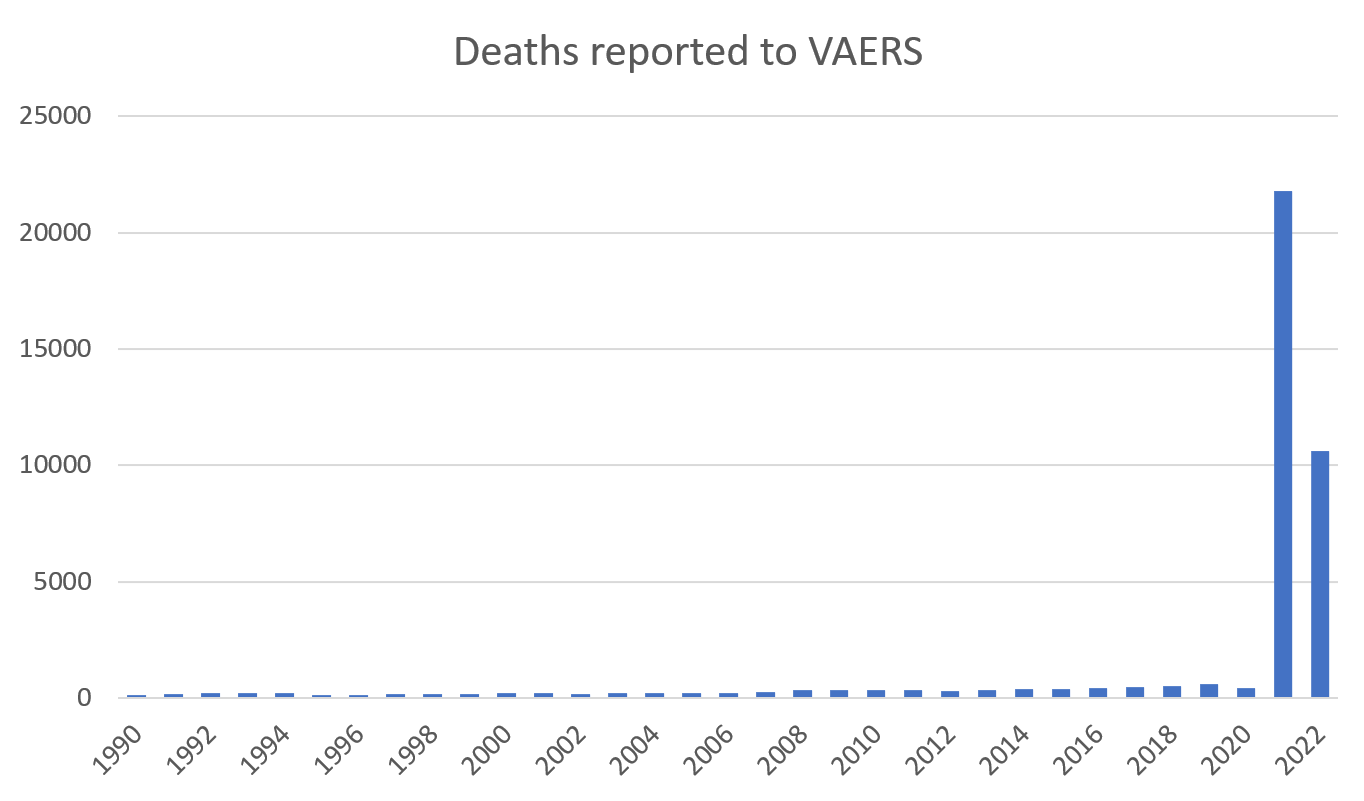
Lack of context: The COVID-19 vaccines were given Emergency Use Authorization by the FDA to speed up the rollout. Unlike a full approval, this comes with greater reporting requirements to VAERS. Therefore, VAERS reports associated with the COVID-19 vaccines are higher than for previous vaccines.

FULL CLAIM: “According to the CDC’s own tracking data, which is recorded by doctors and hospitals, more people have been killed by the COVID vaccines in the last 20 months, than all the other vaccines in the world over the last thirty years combined.”
REVIEW
Even after vaccines have completed clinical trials, the U.S. Centers for Disease Control and Prevention (CDC) continues to monitor vaccine safety in the general public. One of the tools the CDC uses is called the Vaccine Adverse Event Reporting System (VAERS).
VAERS allows doctors, patients, and families to report any adverse events that happen after vaccination, regardless of whether the vaccine caused them or not. These adverse events cover a wide range of instances, including many medical conditions as well as road traffic accidents (578 reports), passive smoking (nine reports), or even “death of pet” (one report). The disclaimer on the site says:
“A report to VAERS does not mean that the vaccine caused the adverse event, only that the adverse event occurred some time after vaccination.”
VAERS is a tool for identifying patterns among adverse events that suggest the vaccine could potentially be the cause. However, this is just the first step in determining if there is a causal link.
Looking solely at the total number of adverse events recorded tells us very little about the safety of a vaccine. When a large number of people receive a vaccine, there will inevitably be a large number of adverse events that happen by chance in the days that follow vaccination.
Unfortunately, since anyone can file a VAERS report, entries are not always reliable. For example, in 2021, the CDC had to remove a false report of a 2-year-old dying after receiving the Pfizer vaccine. The VAERS website warns:
“Some reports may contain information that is incomplete, inaccurate, coincidental, or unverifiable […] Most reports to VAERS are voluntary, which means they are subject to biases.”
VAERS reports have been repeatedly misinterpreted regarding COVID-19 vaccine safety
Since the start of the COVID-19 vaccine rollout, there have been several instances of disinformation using VAERS figures to create concerns about the vaccines’ safety. Health Feedback previously debunked many such claims revolving around the general theme of a spike in VAERS reports, like one about an alleged increase in deaths and another about miscarriages.
Pearson Sharp, a journalist and host at One American News Network, claimed in a tweet on 1 November 2022 that “more people have been killed by the COVID vaccines in the last 20 months, than all the other vaccines in the world over the last thirty years, COMBINED”. Sharp’s tweet was retweeted more than 8,300 times. Screenshots of the tweet also began circulating on social media, for instance, in this Instagram post.
This claim highlighted a dramatic increase in deaths reported to VAERS in 2021 and 2022 compared to previous years. However, this is due to the regulations applied to the COVID-19 vaccines.
Following the positive results from clinical trials, the FDA awarded Emergency Use Authorization (EUA) to three COVID-19 vaccines. This is a mechanism for allowing vaccines to be rolled out more quickly in a public health emergency.
Reporting requirements led to increase in VAERS entries
The EUA means that all manufacturers and healthcare providers administering COVID-19 vaccines must report all serious adverse events “regardless of whether the reporter thinks the vaccine caused the AE [adverse event].”
This reporting requirement doesn’t apply to other vaccines that are used routinely, like those against the flu or given during childhood. For these approved vaccines, only deaths that are linked to known side effects need to be reported.
The FDA fully approved the Pfizer-BioNTech COVID-19 vaccine in August 2021 for people aged 16 and over, and in July 2022 for children aged 12 to 15. It also approved the Moderna vaccine in January 2022 for all adults. However, the VAERS reporting rules for these vaccines remain the same as under the EUA. The newer bivalent booster vaccines are authorized under EUAs, so are also subject to heightened reporting requirements.
Since the start of the rollout, the U.S. population has received over 600 million COVID-19 vaccine doses. So, a sharp rise in VAERS reports is unsurprising. Pearson’s tweet included a graph similar to the one below showing this increase. However, the tweet left out the fact that the VAERS reporting requirements for COVID-19 vaccines are higher than for previous vaccines, leaving readers with a misleading impression.

Figure 1. Deaths reported to VAERS in all locations (including the U.S. and abroad) each year since 1990. The sharp rise is due to the mass rollout of the COVID-19 vaccines issued under Emergency Use Authorization. Source: CDC WONDER, 2 November 2022.
In addition, a study by the CDC in 2021 found that vaccinated people are less likely to die of reasons unrelated to COVID-19[1]. This effect was confirmed after accounting for differences in age, sex, and ethnicity between vaccinated and unvaccinated groups. This directly contradicts any suggestion that the COVID-19 vaccines caused a significant increase in deaths.
Deaths reported to VAERS are investigated in detail
For VAERS reports of death in the U.S., clinicians at the CDC and FDA (Food and Drug Administration) review the details using death certificates, autopsy, and medical records. With this additional information, the clinicians can determine if the vaccine could plausibly have caused the death.
The CDC said that this monitoring had identified nine deaths causally associated with the Johnson & Johnson (J&J) COVID-19 vaccine. These deaths were due to thrombosis with thrombocytopenia syndrome, a rare side effect that causes blood clots and low platelet levels. However, this represents an extremely small proportion of the almost 19 million J&J vaccine doses administered in the U.S. It is also important to place this in the context of COVID-19 deaths, which the vaccines help to prevent. To date, more than one million people have died from COVID-19 in the U.S.
In December 2021, the CDC recommended healthcare providers should prioritize the Pfizer-BioNTech and Moderna vaccines over the J&J vaccine. Then, in May 2022, the FDA placed restrictions on who could receive it.
As this case shows, the ongoing vaccine monitoring system can effectively detect extremely rare causes of death that occur in less than one in a million people.
In summary, it is entirely incorrect to describe reports of death in VAERS as being due to the vaccine. The system is simply a place to record any post-vaccine adverse events regardless of cause, so that they can be examined in detail later if necessary. The increase in deaths reported to VAERS in 2021 and 2022 resulted from heightened reporting requirements for the COVID-19 vaccines. Out of 600 million vaccine doses, nine deaths were due to side effects from a vaccine that is rarely used.
UPDATE (8 November 2022):
This review was updated to clarify that the Pfizer-BioNTech and Moderna COVID-19 vaccines are still subject to the EUA reporting rules for VAERS even after FDA approval. This update does not affect the verdict of the review.
REFERENCE
1 – Xu et al. (2021) COVID-19 Vaccination and Non–COVID-19 Mortality Risk — Seven Integrated Health Care Organizations, United States, December 14, 2020–July 31, 2021. Morbidity and Mortality Weekly Report.


